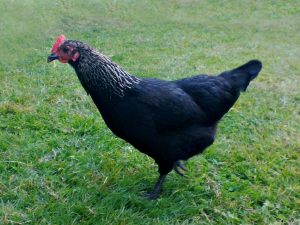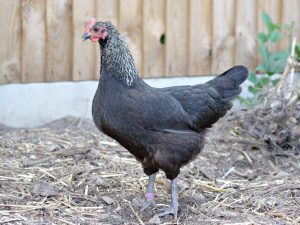Overview
The Norfolk Grey chicken is named after the English country Norfolk, in which the breed was first created. They are estimated to have been first bred between 1909 and 1914 by Fedrick W Myhall and he originally called the breed ‘Black Maria’. During the First World War, Myhall left the breed to their own devices and upon his return realized that they had crossbreed with other English breeds. This breed originated from a cross between the Partridge Wyandottes and the Birchen English Gamebird.
The breed was thought to be extinct by the 1960s, but, there was a discovery of a small flock in 1974 and with a great effort to boost the numbers the breed was revived. Despite managing to come back from near extinction, this breed is still extremely rare and endangered. Nowadays, this breed is very rarely found outside of Norfolk, let alone outside of England.
Males weigh on average 7lbs (3.2kgs) and females weigh around 6lbs (2.7kgs).
Eggs
Size
Medium-sized eggs
Color
Tinted colored eggs
Production per year
150-220 eggs per annum, this breed lays throughout winter
When do they start laying eggs?
As early as 16 weeks
Norfolk Grey Characteristics
Temperament / Are they good as pets?
This bird is best kept in a large space, so would not be ideal as a back yard chicken. They are fairly friendly but you should always exercise caution when you bring small children and other small animals around chickens.
How do I tame Norfolk Grey chickens?
The most effective way to tame chickens is to handle them from a young age; handling them gets them used to human contact. If your birds are already mature then you can tame them by having them eat out of your hand.
How many do I need to buy?
Chickens don’t like to be kept alone so you always need at least one other chicken in order to keep it company. It’s best to have many more as chickens prefer to be in groups, we recommend a minimum flock size of 6.
How much space do they need?
This breed prefers to be kept free-range, this means they need at least 250 square feet per chicken. If you’re keeping these birds for show purposes you need to make sure that their space is partly shaded as the sun can alter the color of their plumage.
Will they mix with my other chickens?
They should mix easily with other chickens. Make sure to be extra vigilant when first mixing your chickens to watch for signs of bullying or aggression.
Appearance
The Norfolk Grey has only one standardized color of plumage, which surprisingly happens to be gray. Despite the plumage being called gray, the majority of feathers on their body are a rich black. Hens have a silver neck whereas males have a silver back, neck, and wings. Their face is a striking red color and they have a single comb. Their legs are clean of feathers and are either slate gray or black. The gorgeous black is shown in the photo below.

Feeding
What should I feed them?
You should feed your chicks growers mash until they are 6 weeks old. Growers mash has a 19{cfcd481556a8b43fba6af451761032bd323e94372a0c1e607} protein content and has all the extra ingredients growing chicks need to help them mature healthily. Once they start getting older they can be fed chicken pellets. Chicken pellets are a pelletized form of chicken feed that has between 15-16{cfcd481556a8b43fba6af451761032bd323e94372a0c1e607} protein content. At 16 weeks your chickens will need different nutrients in order to help them with egg production. You can slowly switch them to layers mash or layers pellets. This has around 16{cfcd481556a8b43fba6af451761032bd323e94372a0c1e607} protein content.
How much should I feed them?
The average chicken usually eats ¼ of a pound (113g) of feed a day. This breed is a larger and heavier breed so once they’ve stopped growing will require a bit more than this. Start by feeding them ¼ of a pound of feed whilst they are still growing and then adjust the weight based on their growth and how quickly they eat this or even if they manage to finish it at all.
What can’t they eat?
There is lots of detailed information on what chickens can and can’t eat on the feed are of our website. The two main foods that shouldn’t be fed to chickens is dried or raw beans and chocolate. This is because these foods contain theobromine and phytohemagglutinin, both of which are lethal to chickens if ingested. In the UK it is illegal to feed chickens and kitchen scraps, as any leftover food may have gone off and then may make your chickens very unwell.
What do I need to keep chickens?
The main thing you need to keep chickens is a decent sized coop that has at least 11 square feet per chicken. A coop that is a little larger than this would be preferable. However 11 square feet per chicken is the minimum amount of space required. To keep your chickens protected from predators you should get a fence that you can sink at least 8 inches into the ground and make sure that it goes around the perimeter of the coop and completely covers the top of the coop.
Their roaming space, which should be at least 250 square feet per chicken, needs a fence around it to stop your chickens from wandering off and getting lost. Inside the coop, you need a little perch for each chicken to stand on as they sleep and wooden laying boxes for the hens to lay their eggs. There should be a water container that the chickens have access to at all times, make sure this container is sturdy so that no chicken can push it over easily. If there is no naturally occurring grit in the vicinity then you’ll need to buy some so that the chickens can use it for egg production.

